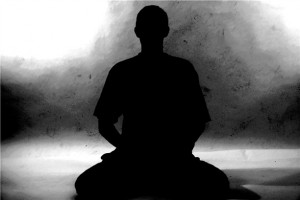After three days of clouds and rain, the sun emerges slowly and unsurely in the afternoon, as if the earth isn’t quite ready for direct light and warmth. Masses of white, gray, and dark clouds remain to the east, but only innocuous clumps of cumulus linger to the west. If they dissipate, I promise myself I’ll hop on the bike and pedal out to the creek at the edge of town.
 Sure enough, the sky clears completely in the vicinity of the quickly declining sun. It feels good to get out, and I’m surprised at the ease with which I pedal against a brisk wind. Within a quarter of an hour, I’m on the bike path that parallels the smaller of the two creeks, which is now running much fuller and faster than the bigger one does during summer.
Sure enough, the sky clears completely in the vicinity of the quickly declining sun. It feels good to get out, and I’m surprised at the ease with which I pedal against a brisk wind. Within a quarter of an hour, I’m on the bike path that parallels the smaller of the two creeks, which is now running much fuller and faster than the bigger one does during summer.
Just as I’m about to turn off onto a dirt path down to the stream, I spot a kite hawk hovering low above the bike path less than a hundred meters ahead. I slow down and keep going, but it flies off toward the fields, though not before halting and hovering twice a short distance away.
Kites are the most aerially graceful birds I’ve ever seen. With long, slender white wings, they hover for a half of a minute or more at a time, and, when they spot some prey, parachute more than plunge with exquisite grace to the ground. Plentiful when I moved to this town less than 20 years ago, now they’re rare, and each sighting, especially when close, feels like an auspicious blessing.
The ground is still damp, but I have pads and plastic, and the sun is warm. It’s the first sitting by the creeks in four days, and I didn’t realize how much I needed it after the sickening events in Connecticut on the 14th. Such evil affects all of us to a much greater degree than we realize.
Passive observation works its wonders however, and as the sun nears the horizon, sliding behind a lone cloud and brilliantly illuminating its edges, thought quiets, time ends, and insight and peace come.
An article in The New York Times recently intoned that “meditation and mindfulness are less about spirituality and more about concentration: the ability to quiet your mind, focus your attention on the present, and dismiss any distractions that come your way.”
There are so many errors in this statement that it’s hard to know where to begin. First, divorcing meditation from spiritual development denies its core intent, and makes meditation just another mind control and stress reduction technique to be sold on the market or made a plaything of science.
Given how wretchedly empty, dark, and dead this culture has become, the superficial view embodied in this article contributes to the inward rot, and robs people of a primary source of spiritual sustenance. And given the depth and extent of alienation and anomie in society, such an approach fuels the nihilism and nullity so many people now feel.
contributes to the inward rot, and robs people of a primary source of spiritual sustenance. And given the depth and extent of alienation and anomie in society, such an approach fuels the nihilism and nullity so many people now feel.
To begin with, it’s essential to make a distinction between concentration and attention, and not blur their meanings.
Attention is not concentration. Concentration implies effort and employs the will to focus the mind, “and dismiss any distractions that come your way.” Concentration is obviously necessary in attaining a goal or completing tasks, but it’s completely misguided with respect to meditation.
Passive observation effortlessly gathers into undirected attention, which is inclusive of every sensation, thought, and emotion that arises. Concentration and control are inimical to meditation precisely because they preclude unwilled attention, which is a capacity of the brain for awareness of patterns and totalities.
It’s crucial to make this distinction, because a meditative state ensues from passive awareness gathering and growing into undirected attention, never from willed concentration that excludes ‘distractions.’ There are no distractions in meditation, because everything that comes into the field of watchful awareness is allowed to be without judgment, evaluation, or exclusion.
With this approach, one’s thought and emotion have the freedom to reveal themselves, and emerge without the direction and distortion of the illusory observer, the ‘me’ and ‘I’ that are actually inextricably part of the field of thought. To awaken observation without the observer is the true beginning of meditation. One has to experiment, and be playfully diligent with it to allow undivided observation and undirected attention to spontaneously ignite.
“Mindful thought” is an oxymoron. Thought cannot be mindful, but the brain has the capacity, completely distinct from the cognitive mechanism, to be deeply attentive of the movement of thought/emotion. That is the essential action of meditation. And attention, acting alone and without volition, quiets the noisy mind, and brings the peace that passes all understanding to the overburdened heart.
Mixing writing down to the reader with trying to impress with phrases like “pathophysiological sites” and “prophylactic effects,” The New York Times article also contains such asinine doozies as this: “Through modifying our practices of thought toward a more Sherlock Holmes-like concentration, we can build up neural real estate that is better able to deal with the variegated demands of the endlessly multitasking, infinitely connected modern world.” God help us. That bit of shallow, silly, and supine thinking makes a serious human being wince.
“Improvements in cognitive function” occur with genuine meditation (which has no technique, method, or ritual), but they are byproducts of deepening undirected attention, not the goal of ‘mindful meditation.’
 Conflating mindfulness with meditation is misleading. Mindfulness simply means being aware of what you’re doing, thinking, and feeling when you’re doing, thinking, and feeling it. Most people in America have no mindfulness, not only because this is an obsessively externalizing culture, but because, contrary to the comforting bromide of the Times article, such self-awareness leads directly to emotional, cultural, and spiritual realities the vast majority of people are doing their damnest to escape seeing and feeling.
Conflating mindfulness with meditation is misleading. Mindfulness simply means being aware of what you’re doing, thinking, and feeling when you’re doing, thinking, and feeling it. Most people in America have no mindfulness, not only because this is an obsessively externalizing culture, but because, contrary to the comforting bromide of the Times article, such self-awareness leads directly to emotional, cultural, and spiritual realities the vast majority of people are doing their damnest to escape seeing and feeling.
The assertion that meditative “states make us more likely to engage the world rather than to withdraw from it” is a half-truth, since authentic meditation allows one to see into (the literal meaning of insight) the cultural and psychological effluvium that produces pathetic murder-suicides like Adam Lanza.
That doesn’t mean one sympathizes with utterly lost souls like this, just that one isn’t able to intellectually and emotionally separate oneself through self-centered exercises in ‘mindful thought.’ Don’t go near meditation if you don’t give a damn or care to give a damn, and are concerned “less about spirituality and more about concentration.”
It’s this kind of mentality that gives meditation a bad name. Meditation is an underground movement, in oneself and in this godforsaken culture. It has to remain underground to quiet the cognitive mechanism of thought and grow the spiritual dimension in the individual brain and being, and thereby bring about a new human being and civilization.
The New York Times article claims that “attention is finite” in the brain, but that too is misleading and wrongheaded. Concentration is finite, but the human brain has a virtually untapped and infinite capacity for attention, which is one and the same with the silence, awareness, and benediction that infuses the universe.
We have only to cease giving thought primacy and learn to attentively quiet the mind.
Martin LeFevre
Link to New York Times article: http://www.nytimes.com/2012/12/16/opinion/sunday/the-power-of-concentration.html?pagewanted=all&_r=1&

